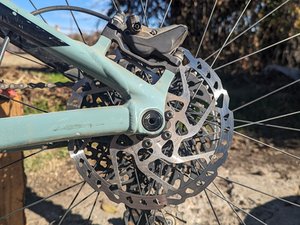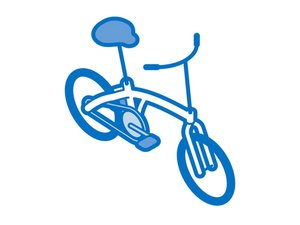Introduction
So you are hitting the steeps of your favorite trail, you brake to enter the first turn and your rotors sing the song of their people. You do not need a descent bell, everyone knows you are coming.
Squeaky brakes are one of the most grating noises you'll deal with riding bikes. Luckily, squeaky brakes can be easily explained and repaired without to much elbow grease.
Causes
If the Brake Calipers are misaligned, then the brake pads may be touching the disc rotor without you pulling the brake lever. This can cause a squeaking sound as well. If you pick up your bike and give your wheel a spin and the wheel slows down considerably, it might be an indicator of a different issue, which you can see on our Disc Brakes Rubbing problem page. Check to see if your brake pads are touching the disc, there should be a little bit of space between the pads and the disc itself.
Surface contamination on your brake rotors can cause them to squeak. There are several ways contamination happens. For instance, take your riding environment: if there is rain, other precipitation, or you simply rode through a puddle, this could be enough to cause squeaking by way of water droplets on your rotors. The same idea applies to dust or any other contaminants. When oiling your chain, take care that none of the oil finds its way onto your rotor. In fact, even when cleaning your rotors, do not handle the braking surface afterwards, as the oils from your skin can cause contamination. Stopping contamination at the rotor level is the quickest and easiest way to prevent or stop squeaking. If unaddressed, contaminants will find their way into the pads themselves and further complicates the troubleshooting process. With all that, how do we clean our rotors? Wipe your rotors down with isopropyl alcohol and a rag to remove surface contamination. After wipe down, if you still see residue, consider resurfacing your rotor by rubbing the surface with some steel wool. Follow this up with another isopropyl alcohol wipe-down. If this does not fix your squeaking problem, keep reading!
If your brake pads have become uneven, you can try to reset the surface by sanding them. Using medium-grit drywall sandpaper is a good option because the holes allow for the excess material to avoid being rubbed back into the brake pad. Sand in a figure-8 motion until the pads are a consistent color (removing old material will show the original pad color and indicate that you are even) and try re-installing the pads. If the pads are too far gone and one is much more worn than the other, the safest option is to get new pads! A great resource on this here.
Your brake pads a porous surface. Allowing surface contamination from your rotors to linger, will cause the contaminant to embed into the pads themselves. This will cause both squeaking and reduced braking performance which is dangerous and annoying. There are a couple methods you can try: remove the brake pads and using a figure-8 motion on some medium grit sandpaper, grind off the contamination at the surface. Or, remove the brake pads and use a heat-gun to try and burn off the contaminants (note: with high enough heat, you could compromise the adhesive holding the pad to the backing material). Either of these methods could revitalize your braking performance, but often times, contaminants are too embedded into the brake pad material and will continue to produce squeaking. Ultimately, replacing the pads altogether should fix the issue.
Bedding-in is a process where a super thin layer of material from the brake pads gets distributed onto the disc rotor itself to help with braking power and keeping contaminants off of the disc. If you have a new bike, you may need to do bed-in your brakes to avoid that squeaking of new discs. Here is how to bed in new brakes according to SRAM:
- Pick a riding spot like a parking lot or street that will allow you to ride moderately quickly. It is best to stay in a seated riding position.
- Start by accelerating the bike to a moderate speed, then firmly and evenly apply the brakes until you are at walking speed, then release the brakes. DO NOT come to a complete stop during this process.
- Repeat this process 20 or so more times. You will feel the brakes biting more, or feeling more powerful.
- Accelerate the bike to a faster speed, then firmly apply the brakes until you are at walking speed, then release the brakes. Repeat this about 10 times.
- Once you are done, let the brakes cool completely to set the material. DO NOT lock up the wheels when dismounting the bike!
If your bike is well-loved, you may have an uneven layer of brake material on each side of the disc, which is an indication of brake pads that are uneven as well. This is a larger issue, and if you have been riding for a long time with uneven pads, the rotor itself is likely going to vibrate or squeak even if you get new pads or clean the disc, since the surface of the rotor has been heated by friction and changed over time.
You could try to resurface the rotor with steel wool, like mentioned above. If your pads are uneven, there could be wheel alignment issues, or a sticky piston on the brake caliper. Check out this page to see what could be causing it.
You're seeing solutions for Bicycle. Select your model to find parts for your device.







